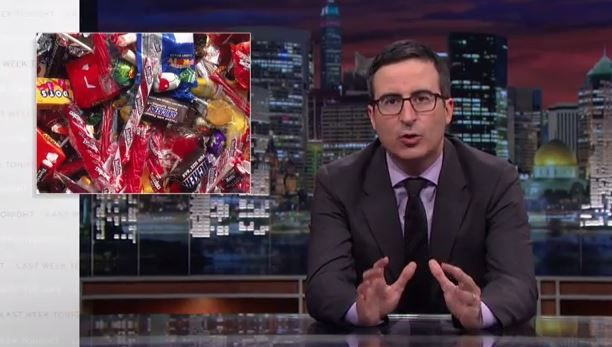John Oliver Calls Out Big Sugar In Time For Halloween, Says Trick-Or-Treating Not Much Of A Treat

Despite a threatening obesity epidemic in the sugar-laden United States, children will not be disappointed with their candy selections as they trick-or-treat this Halloween. John Oliver announced on Sunday night’s Last Week Tonight show, that Americans are predicted to spend $2.2 billion on Halloween candy this year.
“We know what Halloween is really about — candy, sweet sugar treats,” Oliver said in the skit. “Is it really fair to describe sugar as a treat considering how much we eat it all year round?” According to the American Heart Association, the average American consumes 22.2 teaspoons a day, which adds up to 355 calories, or three times the recommended dosage.
We react so viscerally because sugar activates a part of the brain similar to cocaine, something seen in brain scans. Knowing this, the $5 billion sugar industry capitalized on our innately designed sweet tooth by incorporating it into any food product it can. There are currently 256 different names and derivatives for sugar. Out of the 600,000 food items sold in America, 80 percent of them have added sugar.
Don’t get natural mixed up with added sugar. Naturally occurring sugars, such as those found in fructose, found in fruit or lactose, which is milk sugar, benefits your body with short and long-term energy balancing. Added sugar, however, is a major problem in America because of its dauntingly high doses and is found in soda, sugars, candy, cakes, cookies, pies, and fruit juice. What’s scarier is where it hides less obviously in crackers, chips, salad dressings, breads, cereals, ketchup, energy and sports drinks, and cocktails.
Currently, the Food and Drug Administration (FDA) is working on overhauling nutritional labeling, and one of the top proposals is to differentiate between naturally occurring sugar and added sugar. The goal is to help the average consumer to not only understand what they are eating, but also how much they're eating of a particular ingredient.
Companies, such as OceanSpray cranberry juice, are flooding the FDA with letters asking that they be exempt from the added sugar labeling because it will deter people from buying their product. They’ve even paid doctors to downplay the dangers of a sugary diet. Oliver points out the conflicted science sprinkled in sugar, which includes those who are funded by sugar coalitions to downplay the dangers of a sugary diet. When the independent researchers who weren’t greased with industry money presented their findings, 83.3 percent of them concluded there was a direct association with increased weight gain or obesity.
Over the past 30 years, Americans have been steadily increasing their added sugar intake at almost the same exact rate as childhood obesity trajectory. This can only lead one to believe there will be a lot of kids dressed up in pumpkin and ghost costumes knocking on our doors this year, and less skeletons and scare crows.
Published by Medicaldaily.com



























